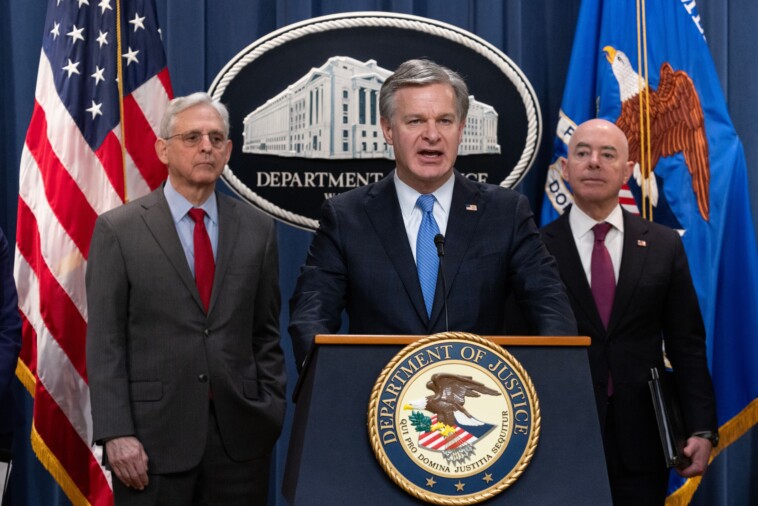Two House Republicans excoriated the FBI Thursday, demanding answers from the bureau over revelations it quietly adjusted some of its crime statistics for 2022 to hide that offenses rose rather than declined.
Last year, the bureau initially estimated that violent crime slipped nationwide by 2.1% in 2022 compared to 2021. But this past September, the FBI quietly released a revision showing that violent crime actually rose 4.5% in that time frame.
Judiciary Committee Chairman Jim Jordan (R-Ohio) and Subcommittee on Crime and Federal Government Surveillance Chairman Andy Biggs (R-Ariz.) sent a scathing letter to FBI Director Christopher Wray Thursday ripping the bureau for not being upfront about the major adjustment.
“The FBI did not publicize its revision of 2022 violent crime data, and the only way to see this change is to download the FBI’s updated crime data and compare it to the previous year,” Jordan and Biggs wrote.
That revision went unmentioned in a September press release boasting about a 3.0% drop in violent crime nationally during the year 2023 compared to 2022. Significantly, that supposed decrease was predicated on the corrected statistics about violent crime spiking in 2022.
“The initial 2022 data, before it was corrected, was heralded as ‘historic declines’ in the crime rate. Despite having the true data, the FBI never issued a clarification while the incorrect statistics were used to push a false narrative,” the lawmakers added.
“The FBI’s revision of violent crime data confirms what our oversight has shown: the Biden-Harris crime epidemic continues to escalate and far-left state and local policymakers place.”
The stats were used during the 2024 presidential election cycle as the basis for numerous fact checks, including during the Sept. 10 debate between President-elect Donald Trump and Vice President Kamala Harris.
The bureau’s methodology for tracking crime has shifted. In 2021, the FBI moved to a new system of collecting crime data — the National Incident-Based Reporting System (NIBRS), retiring its Summary Reporting System (SRS).
NIBRS reports much more specific crime information than SRS, however, reporting rates from law enforcement have slipped as municipalities seemingly struggled with the transition.
That has prompted many experts on crime to stress that the data is incomplete. By one analysis, the bureau lacks data from about 20% of key local agencies and the reporting rate dropped below 70% in 2021 for the first time in at least two decades.
The Crime Prevention Research Center first flagged the FBI’s quiet adjustment in a story that was published by RealClearInvestigations.
Jordan and Biggs are demanding all documentation and communication related to the “FBI’s process for updating” the data as well as details about actions taken by the bureau to update the public on the revision.
The bureau has until Nov. 21 to fork over that information and to arrange a staff briefing about the matter.
In the letter, Jordan and Biggs said they wanted to know the process the FBI uses for updating its statistics, details about the lack of reporting from municipalities, how often the bureau has corrected statistics from prior years, and steps taken to ensure the 2023 data is accurate.
“The FBI’s failure to be transparent about violent crime data continues to erode the American people’s trust and raises questions about the agency’s procedures used to track and update the UCR [Uniform Crime Reporting data],” the Republican congressmen added.
“Americans have known all along what the FBI is now finally reporting—crime is continuing to escalate across the country and Americans do not feel safe in their communities.”
In response to a request for comment from the bureau referred The Post to its past statement explaining the violent crime data revision.
“A significant number of agencies were unable to complete the transition to NIBRS in 2021. Due to the lower volume of participation, the FBI was unable to produce the traditional national estimates for 2021,” the FBI said.
“September’s release of Crime in the Nation, 2023, was the first phase in the FBI’s efforts to provide the public with more timely data. The next phase will see a shift to monthly data releases to promote transparency and provide an opportunity for consumers to review data based on more timely crime counts.”
Jordan and Biggs’ missive to Wray came two days after Trump’s victory in the presidential election.
Trump, 78, nominated Wray for a 10-year term as FBI director in 2017, but congressional Republicans — and Trump himself — have chafed at his leadership throughout the Harris-Biden administration.







